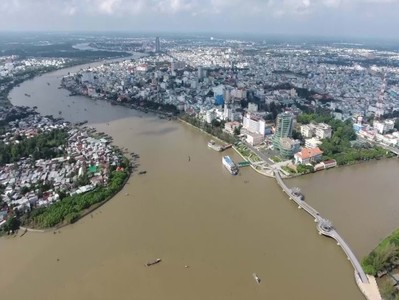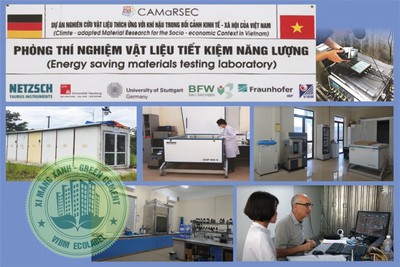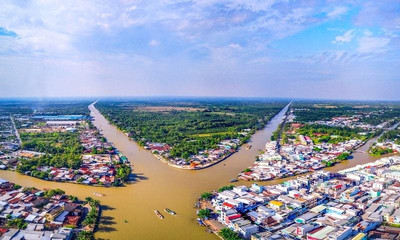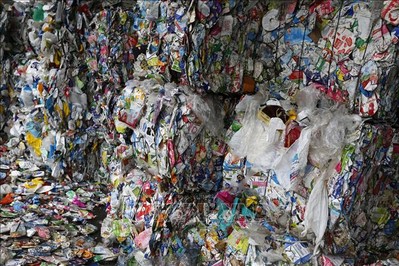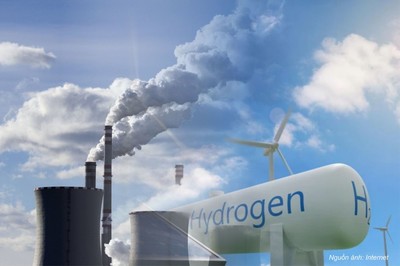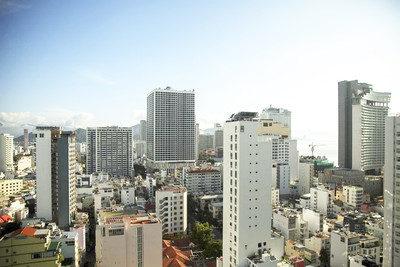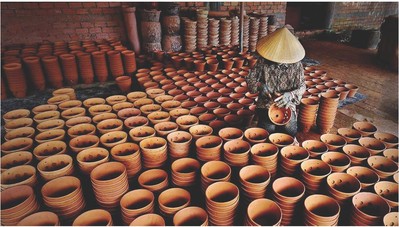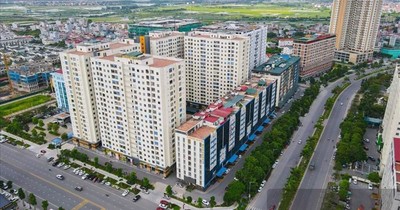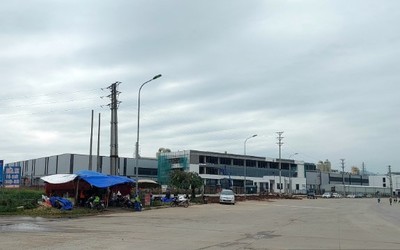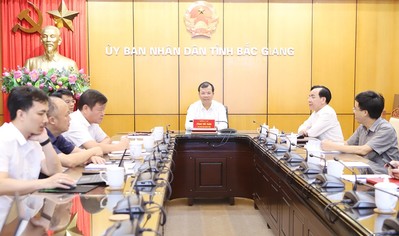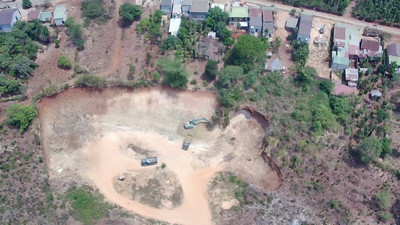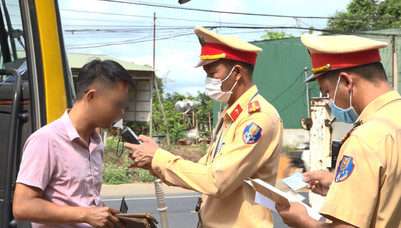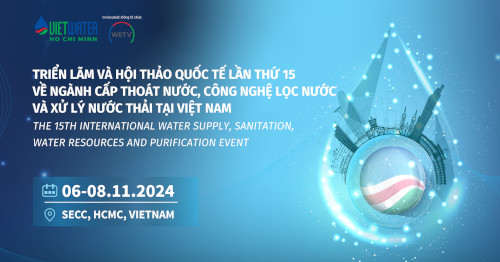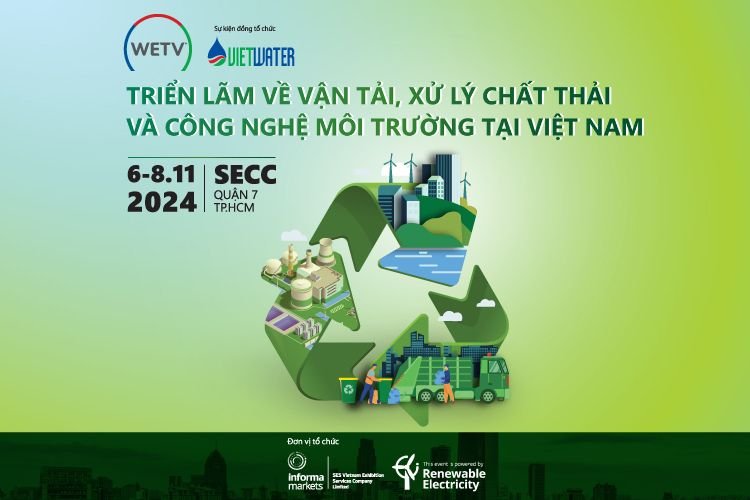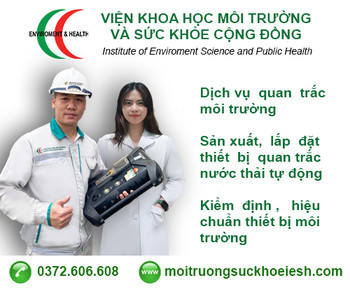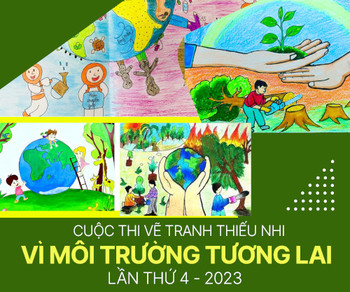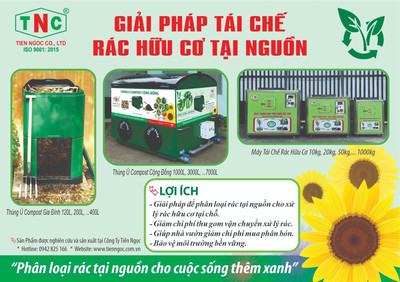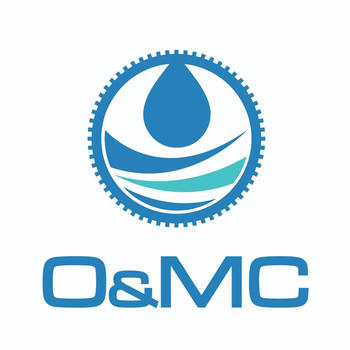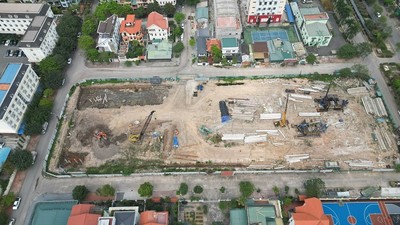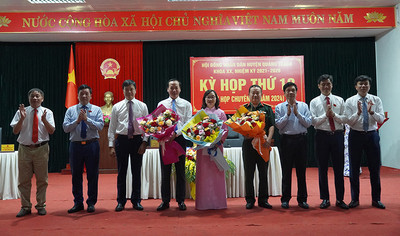Công bố quốc tế lĩnh vực môi trường số 24-2023
Trân trọng giới thiệu tới quý độc giả Công bố quốc tế lĩnh vực môi trường số 24-2023 với những nội dung chính như sau:
Về quản lý môi trường
- Tai nạn lao động, biến đổi khí hậu và COVID-19.
- Dự trữ carbon sinh khối và thay đổi trữ lượng trong hàng rào được quản lý.
- Phân tích toàn diện đặc tính vi ô nhiễm của nước thải trong cuộc khủng hoảng Covid-19 năm 2020: Sàng lọc nghi ngờ và chiến lược ưu tiên rủi ro môi trường.
- Phơi nhiễm ô nhiễm không khí và suy tim: Đánh giá hệ thống và phân tích tổng hợp.
- Hội nghị CICTA2021: Giám sát môi trường, đánh giá rủi ro và nghiên cứu khắc phục ở Iberoamerica.
- Tác động của việc phân loại và xử lý rác đối với sự xuất hiện của dược phẩm và các sản phẩm chăm sóc cá nhân trong nước rò rỉ chất thải rắn đô thị: Một nghiên cứu trường hợp ở Thượng Hải.
- Một mô hình cấp hệ thống về các liên kết trực tiếp và gián tiếp giữa sức khỏe môi trường, các yếu tố kinh tế xã hội và tỷ lệ tử vong của con người.
- Đặc điểm ô nhiễm và rủi ro sinh thái của các nguyên tố vi lượng trong PM2.5 trên ba địa điểm thuộc mạng lưới COALESCE - Bhopal, Mesra và Mysuru, Ấn Độ.
- Khai thác đô thị từ sinh khối, nước muối, bùn thải, phosphogypsum và chất thải điện tử để giảm ô nhiễm môi trường: Hiện trạng sẵn có, tiềm năng và công nghệ tập trung vào LCA và TEA.
Về môi trường đô thị
- Xác định nguồn nitrat của nước ngầm và sông trong môi trường đô thị phức tạp dựa trên bằng chứng đồng vị và thủy hóa học.
- Tác động của nấu ăn thương mại đối với PM2.5 và O3 đô thị với kiểm kê phát thải được hỗ trợ bởi dữ liệu trực tuyến.
- So sánh hiệu quả làm mát của các kịch bản kết hợp bề mặt đô thị có thể vận hành để giảm nhiệt mùa hè.
- Bằng chứng về hạt vi nhựa trong nước rỉ rác của bãi rác Randegan, Thành phố Mojokerto, Indonesia và khả năng gây ô nhiễm nước mặt của nó.
- Ảnh hưởng của can thiệp lọc không khí trong nhà đối với huyết áp, độ bão hòa oxy trong máu và sự thay đổi nhịp tim: Một thử nghiệm ngẫu nhiên có đối chứng mù đôi đối với những người trẻ tuổi khỏe mạnh.
- Tác động của nhiệt đối với tỷ lệ tử vong do mọi nguyên nhân và nguyên nhân cụ thể: Một nghiên cứu ở nhiều thành phố ở Texas.
- Mối liên hệ ngắn hạn giữa ô nhiễm không khí với tỷ lệ tử vong do ung thư phổi ở Osaka, Nhật Bản.
- Các mô hình chéo trường hợp đa ô nhiễm về tỷ lệ tử vong do mọi nguyên nhân và nguyên nhân cụ thể và nhập viện theo nhóm tuổi ở 47 thành phố của Canada.
- Giám sát dựa trên nước thải cho thấy xu hướng thời gian - không gian địa lý đối với mầm bệnh kháng kháng sinh trong một cộng đồng đô thị lớn.
Về môi trường khu công nghiệp
- Đánh giá những thay đổi về nồng độ hạt nhân phóng xạ và mực nước ngầm trước và sau khi rút ao làm mát ở vùng lân cận Nhà máy điện hạt nhân Chornobyl.
- Tìm hiểu về quá trình thụ động hóa cadmium và quá trình khoáng hóa nitơ của lignin amin hóa trong đất.
- Xử lý chất thải keo tụ cation dựa trên lignin xử lý nước thải nhuộm: Chế tạo, hiệu suất và cơ chế.
- Xử lý môi trường đất bị ô nhiễm Pb-Cd bằng axit photphonic hữu cơ-saponin: Điều kiện, hiệu quả, rủi ro sinh thái và khả năng phục hồi.
- Sự xuất hiện của nhựa trong cá đánh bắt ở Vịnh İzmit công nghiệp hóa cao (Biển Đông Marmara, Türkiye).
- Sự xuất hiện của florua trong môi trường, các quy định và phương pháp xử lý đất: Đánh giá toàn diện.
- Khử cacbon trong ngành công nghiệp và tác động của nó đối với vận hành lưới truyền tải điện - Ý nghĩa từ một phân tích dựa trên mô hình cho Đức.
- Thiết kế và đánh giá kinh tế của quy trình thu giữ CO2 dựa trên amin mới cho các nhà máy sản xuất hydro dựa trên SMR.
- Hydrochar pha tạp nitơ được điều chế bằng sinh khối và nước thải chứa nitơ để hấp phụ thuốc nhuộm: Ảnh hưởng của nguồn nitơ trong nước thải đến hiệu suất hấp phụ của hydrochar.

CHUYÊN TRANG QUẢN LÝ MÔI TRƯỜNG
Tạp chí Môi trường và Đô thị Việt Nam
Xin trân trọng giới thiệu!
1. Work accidents, climate change and COVID-19
Science of The Total Environment, Volume 871, 1 May 2023, 162129
Abstract
The effects brought by climate change and the pandemic upon worker health and wellbeing are varied and necessitate the identification and implementation of improved strategic interventions. This review aims, firstly, to assess how climate change affects occupational accidents, focusing on the impacts of extreme air temperatures and natural disasters; and, secondly, to analyze the role of the pandemic in this context. Our results show that the manifestations of climate change affect workers physically while on the job, psychologically, and by modifying the work environment and conditions; all these factors can cause stress, in turn increasing the risk of suffering a work accident.
There is no consensus on the impact of the COVID-19 pandemic on work accidents; however, an increase in adverse mental effects on workers in contact with the public (specifically in healthcare) has been described. It has also been shown that this strain affects the risk of suffering an accident.
During the pandemic, many people began to work remotely, and what initially appeared to be a provisional situation has been made permanent or semi-permanent in some positions and companies. However, we found no studies evaluating the working conditions of those who telework.
In relation to the combined impact of climate change and the pandemic on occupational health, only publications focusing on the synergistic effect of heat due to the obligation to wear COVID-19-specific PPE, either outdoors or in poorly acclimatized indoor environments, were found.
It is essential that preventive services establish new measures, train workers, and determine new priorities for adapting working conditions to these altered circumstances.
2. Biomass carbon stocks and stock changes in managed hedgerows
Science of The Total Environment, Volume 871, 1 May 2023, 162073
Abstract
Landscape features, such as hedgerows, can play a role in enhancing terrestrial carbon (C) sinks, especially in North-western Europe, where they form a large part of the agricultural landscape. To date, there are few studies relating aerial imagery to ground-truthed biomass measurements and relating changes in biomass to hedgerow management. This study sought to develop relationships between measured biomass of hedgerows and digital elevation model (DEM) data from drones and aircraft. Furthermore, changes in hedgerow above-ground and below-ground biomass stocks were assessed using a systematic grid sample, DEM data and developed volume-biomass regression models. The developed inventory framework was then applied to a pilot study area of 419,701 ha in Ireland.
Robust relationships were developed relating DEM data to volume and above-ground biomass. Model equations were also developed linking above-ground and below-ground biomass. However, these were less robust due to the confounding impacts of hedgerow management intensity, hedgerow type and dominant species. Above-ground biomass density was linearly correlated with hedge volume. Wider, less intensively managed, irregular hedges exhibit a higher biomass stocks per km, when compared to regular, more intensively managed hedgerows. When the models were extrapolated to the county level, hedgerow biomass C pools for Co Wexford and Waterford are suggested to be a net emission of −0.3 tC ha−1 year−1 due to hedgerow removals and management. Flailing or coppicing of hedgerows, in particular irregular profile hedgerows, had the largest impact on the biomass C balance in the pilot study area. Re-introduction of traditional management practices such as layering and increasing the allowable hedgerow width in areas qualifying for farm payments could be considered with the aim of increasing the maximum sink potential of established hedgerows.
3. Air pollution exposure and heart failure: A systematic review and meta-analysis
Science of The Total Environment, Volume 872, 10 May 2023, 162191
Abstract
While the literature strongly supports a positive association between particulate matter with diameter ≤ 2.5 μm (PM2.5) exposure and heart failure (HF), there is uncertainty regarding the other pollutants and the dose and duration of exposure that triggers an adverse response. To comprehensively assess and quantify the association of air pollution exposure with HF incidence and mortality, we performed separate meta-analyses according to pollutant types [PM2.5, PM10, sulfur dioxide (SO2), nitrogen dioxide (NO2), carbon monoxide (CO), ozone (O3)], and exposure duration (short- and long-term). We systematically searched PubMed, EMBASE, and Web of Science for relevant articles with publication dates up to July 12, 2022, identifying 35 eligible studies. Random-effects models were used to summarize the pooled odds ratios (ORs) and 95 % confidence intervals (95 % CIs). For long-term exposure, the growing risk of HF was significantly associated with each 10 μg/m3 increase in PM2.5 (OR = 1.196, 95 % CI: 1.079–1.326; I2 = 76.8 %), PM10 (1.190, 1.045–1.356; I2 = 76.2 %), and NO2 (1.072, 1.028–1.118; I2 = 78.3 %). For short-term exposure, PM2.5, PM10, NO2, and O3 (per 10 μg/m3 increment) increased the risk of HF, with estimated ORs of 1.019 (1.008–1.030; I2 = 39.9 %), 1.012 (1.007–1.017; I2 = 28.3 %), 1.016 (1.005–1.026; I2 = 53.7 %), and 1.006 (1.002–1.010; I2 = 0.0 %), respectively. No significant effects of SO2 and CO exposure on the risk of HF were observed. In summary, our study powerfully highlights the deleterious impact of PM2.5, PM10, and NO2 exposure (either short- or long-term) on HF risk. Serious efforts should be made to improve air quality through legislation and interdisciplinary cooperation.
4. Comprehensive micropollutant characterization of wastewater during Covid-19 crisis in 2020: Suspect screening and environmental risk prioritization strategy
Science of The Total Environment, Volume 873, 15 May 2023, 162281
Abstract
Micropollutants monitoring in wastewater can serve as a picture of what is consuming society and how it can impact the aquatic environment. In this work, a suspect screening approach was used to detect the known and unknown contaminants in wastewater samples collected from two wastewater treatment plants (WWTPs) located in the Basque Country (Crispijana in Alava, and Galindo in Vizcaya) during two weekly sampling campaigns, which included the months from April to July 2020, part of the confinement period caused by COVID-19. To that aim, high-resolution mass spectrometry was used to collect full-scan data-dependent tandem mass spectra from the water samples using a suspect database containing >40,000 chemical substances. The presence of > 80 contaminants was confirmed (level 1) and quantified in both WWTP samples, while at least 47 compounds were tentatively identified (2a). Among the contaminants of concern, an increase in the occurrence of some compounds used for COVID-19 disease treatment, such as lopinavir and hydroxychloroquine, was observed during the lockdown.
A prioritization strategy for environmental risk assessment was carried out considering only the compounds quantified in the effluents of Crispijana and Galindo WWTPs. The compounds were scored based on the removal efficiency, estimated persistency, bioconcentration factor, mobility, toxicity potential and frequency of detection in the samples. With this approach, 33 compounds (e.g. amantadine, clozapine or lopinavir) were found to be considered key contaminants in the analyzed samples based on their concentration, occurrence and potential toxicity. Additionally, antimicrobial (RQ-AR) and antiviral (EDRP) risk of certain compounds was evaluated, where ciprofloxacin and fluconazole represented medium risk for antibiotic resistance (1 > RQ-AR > 0.1) in the aquatic ecosystems. Regarding mixture toxicity, the computed sum of toxic unit values of the different effluents (> 1) suggest that interactions between the compounds need to be considered for future environmental risk assessments.
5. CICTA2021 conference: Environmental monitoring, risk assessment and remediation studies in Iberoamerica
Science of The Total Environment, Volume 873, 15 May 2023, 162436
Abstract
Iberoamerica comprises countries where Portuguese or Spanish are the predominant languages. In addition to sharing language, the countries of Iberoamerica have close relationships of origins, culture and scientific research, including studies in the field of environmental contamination and toxicology. In this context, the Iberoamerican Society for Contamination and Environmental Toxicology (SICTA) has been working since 2000 to bring together, biannually, researchers to discuss advances in science regarding impacts of pollutants on natural environments, at the Iberoamerican Congress of Environmental Contamination and Toxicology (CICTA). The 9th Congress of SICTA (CICTA2021) occurred in Blumenau, south Brazil, in november/2021 with the participation of 150 researchers presenting about 120 different studies. This special issue of STOTEN was aimed to publish selected studies of relevant impact that were presented at CICTA2021, resulting in six papers focused on environmental monitoring, risk assessment and remediation of polluted areas.
The first study evaluated the use of enhancers (two cyclodextrins and a rhamnolipid biosurfactant) to increase the biotic degradability of a mix of Polycyclic Aromatic Hydrocarbons (PAHs) in soils, showing their greater efficacy for biodegradation of low molecular weight PAHs compared to high molecular weight ones. The second study tested strategies of biostimulation (nutrients increment), bioaugmentation of soil microbiota using consortiums of natural and isolated bacteria, and bioavailability enhancement (addition of surfactant cyclodextrin to soil) to increase the degradation of the herbicide trifluralin. Isolated or combined used of these strategies showed increment of trifluralin degradation in soil.
The third remediation study tested the efficacy of different bacterial strains that were isolated from sewage sludge on the biodegradation of nonylphenol, through bioaugmentation processes of the sludge. One of the strains (Bacillus safensis CN12) showed great potential for nonylphenol biodegradation, especially if included in a consortium with other bacteria, and in combination with cyclodextrin as availability enhancer and glucose as an additional carbon source.
6. Impacts of garbage classification and disposal on the occurrence of pharmaceutical and personal care products in municipal solid waste leachates: A case study in Shanghai
Science of The Total Environment, Volume 874, 20 May 2023, 162467
Abstract
Leachate generated during the treatment and disposal of municipal solid wastes (MSWs) can be an important source of pharmaceutical and personal care products (PPCPs) in the environment. With the implementation of garbage classification policy in China, the disposal methods of MSWs have changed, while its impacts on the occurrence of PPCPs in the generated leachate remain unknown. In this study, we investigated 49 target PPCPs in the leachates of classified MSWs, i.e. residual waste leachate (RWL) and food waste leachate (FWL), and revealed the influence of garbage classification implementation on the occurrence of PPCPs in leachates to be treated. The results showed the concentration and mass load of target PPCPs in the RWL samples (median values: 34.9 ng/L and 52.3 mg/d, respectively) were significantly higher than those in the FWL samples (median values: 19.3 ng/L and 14.5 mg/d, respectively). Macrolide (ML) antibiotics were the predominant PPCPs in the RWL samples, while in the FWL samples, quinolone (QL) antibiotics exhibited the highest concentration and mass load. The implementation of garbage classification policy led to the reduction of PPCP mass load (from 739 g/d to 262 g/d) in leachates to be treated. The findings are helpful for better designing or managing MSW treatment and disposal processes to minimize the emission of PPCPs from MSW leachates.
7. A systems-level model of direct and indirect links between environmental health, socioeconomic factors, and human mortality
Science of The Total Environment, Volume 874, 20 May 2023, 162486
Abstract
Major efforts are being made to better understand how human health and ecosystem health are influenced by climate and other environmental factors. However, studies that simultaneously address human and ecosystem health within a systems-level framework that accounts for both direct and indirect effects are rare. Using path analysis and a large database of environmental and socioeconomic variables, we create a systems-level model of direct and indirect effects on human and ecosystem health in counties throughout the conterminous United States. As indicators of human and ecosystem health, we use age-adjusted mortality rate and an index of biological integrity in streams and rivers, respectively. We show that: (i) geology and climate set boundary conditions for all other variables in the model; (ii) hydrology and land cover have predictable but distinct effects on human and ecosystem health; and (iii) forest cover is a key link between the environment and the socioeconomic variables that directly influence human health.
8. Pollution characteristics and ecological risks of trace elements in PM2.5 over three COALESCE network sites - Bhopal, Mesra, and Mysuru, India
Chemosphere, Volume 324, May 2023, 138203
Abstract
Time-synchronized, 24 h integrated PM2.5 trace element (TE) measurements made as a part of the COALESCE project (Venkataraman et al., 2020) at Bhopal, Mesra, and Mysore during all of 2019 were analyzed in this study. The concentrations of 15 key elements ranged between 0.05 ng m−3 and 50 μg m−3 across the study sites. Pronounced seasonal variation of elements from multiple source classes showed that the crustal origin elements (Al, Si, Fe, Ti, and Ca) peaked during the pre-monsoon season, while the anthropogenic activities driven element (P, S, K, V, Mn, Cu, Zn, and Pb) concentrations increased during the winter and post-monsoon seasons. Spearman correlation coupled with hierarchical clustering separated the matrix of elements into three common clusters at all sites, corresponding to crustal sources, combustion and biomass burning emissions, and industrial/non-exhaust vehicular emissions, respectively.
Furthermore, episodes of metal pollution throughout the year were examined using characteristic radar charts of TEs to identify the association between TE sources and poor air quality. For example, maximum metal pollution in Bhopal occurred during the post-monsoon season, attributable to biomass burning, dust storms, industrial and non-exhaust vehicular emissions. Finally, an ecological risk assessment revealed that the risk index was higher than the threshold value of 600 for all heavy metals at all sites. Pb, Cu, and Zn were the top contributors to ‘extremely high risk’ amongst all heavy metals. Overall, the results show that although TE concentrations at all three locations were much lower than in other urban locations in India, the risk from heavy metals to the ecosystem (and likely to human health) cannot be ignored. The findings warrant a full source apportionment of fine PM to better identify TE-rich source contributions and future studies to examine the atmospheric processing and eco-system uptake of TEs.
9. Urban mining from biomass, brine, sewage sludge, phosphogypsum and e-waste for reducing the environmental pollution: Current status of availability, potential, and technologies with a focus on LCA and TEA
Environmental Research, Volume 224, 1 May 2023, 115523
Abstract
Rapid industrialization, improved standards of living, growing economies and ever-increasing population has led to the unprecedented exploitation of the finite and non-renewable resources of minerals in past years. It was observed that out of 100 BMT of raw materials processed annually only 10% is recycled back. This has resulted in a strenuous burden on natural or primary resources of minerals (such as ores) having limited availability. Moreover, severe environmental concerns have been raised by the huge piles of waste generated at landfill sites.
To resolve these issues, ‘Urban Mining’ from waste or secondary resources in a Circular Economy’ concept is the only sustainable solution. The objective of this review is to critically examine the availability, elemental composition, and the market potential of the selected secondary resources such as lignocellulosic/algal biomass, desalination water, sewage sludge, phosphogypsum, and e-waste for minerals sequestration. This review showed that, secondary resources have potential to partially replace the minerals required in different sectors such as macro and microelements in agriculture, rare earth elements (REEs) in electrical and electronics industry, metals in manufacturing sector and precious elements such as gold and platinum in ornamental industry. Further, inputs from the selected life cycle analysis (LCA) & techno economic analysis (TEA) were discussed which showed that although, urban mining has a potential to reduce the greenhouse gaseous (GHG) emissions in a sustainable manner however, process improvements through innovative, novel and cost-effective pathways are essentially required for its large-scale deployment at industrial scale in future.
10. The impact of wildfires on air pollution and health across land use categories in Brazil over a 16-year period
Environmental Research, Volume 224, 1 May 2023, 115522
Abstract
Forest fires cause many environmental impacts, including air pollution. Brazil is a very fire-prone region where few studies have investigated the impact of wildfires on air quality and health. We proposed to test two hypotheses in this study: i) the wildfires in Brazil have increased the levels of air pollution and posed a health hazard in 2003–2018, and ii) the magnitude of this phenomenon depends on the type of land use and land cover (e.g., forest area, agricultural area, etc.). Satellite and ensemble models derived data were used as input in our analyses. Wildfire events were retrieved from Fire Information for Resource Management System (FIRMS), provided by NASA; air pollution data from the Copernicus Atmosphere Monitoring Service (CAMS); meteorological variables from the ERA-Interim model; and land use/cover data were derived from pixel-based classification of Landsat satellite images by MapBiomas.
We used a framework that infers the "wildfire penalty” by accounting for differences in linear pollutant annual trends (β) between two models to test these hypotheses. The first model was adjusted for Wildfire-related Land Use activities (WLU), considered as an adjusted model. In the second model, defined as an unadjusted model, we removed the wildfire variable (WLU). Both models were controlled by meteorological variables.
We used a generalized additive approach to fit these two models. To estimate mortality associated with wildfire penalties, we applied health impact function. Our findings suggest that wildfire events between 2003 and 2018 have increased the levels of air pollution and posed a significant health hazard in Brazil, supporting our first hypothesis. For example, in the Pampa biome, we estimated an annual wildfire penalty of 0.005 μg/m3 (95%CI: 0.001; 0.009) on PM2.5. Our results also confirm the second hypothesis. We observed that the greatest impact of wildfires on PM2.5 concentrations occurred in soybean areas in the Amazon biome. During the 16 years of the study period, wildfires originating from soybean areas in the Amazon biome were associated with a total penalty of 0.64 μg/m3 (95%CI: 0.32; 0.96) on PM2.5, causing an estimated 3872 (95%CI: 2560; 5168) excess deaths. Sugarcane crops were also a driver of deforestation-related wildfires in Brazil, mainly in Cerrado and Atlantic Forest biomes.
Our findings suggest that between 2003 and 2018, fires originating from sugarcane crops were associated with a total penalty of 0.134 μg/m3 (95%CI: 0.037; 0.232) on PM2.5 in Atlantic Forest biome, resulting in an estimated 7600 (95%CI: 4400; 10,800) excess deaths during the study period, and 0.096 μg/m3 (95%CI: 0.048; 0.144) on PM2.5 in Cerrado biome, resulting in an estimated 1632 (95%CI: 1152; 2112) excess deaths during the study period. Considering that the wildfire penalties observed during our study period may continue to be a challenge in the future, this study should be of interest to policymakers to prepare future strategies related to forest protection, land use management, agricultural activities, environmental health, climate change, and sources of air pollution.
11. How new-type urbanization pilots reduce carbon emissions: A technology progress paths perspective
Journal of Cleaner Production, Volume 401, 15 May 2023, 136663
Abstract
As an important attempt to promote intensive development, new-type urbanization (NU) pilot programs have received increasing attention. However, most related literature does not clarify the relationships between the NU pilot, paths of technological progress, and carbon emissions. Thus, we constructed a difference-in-differences model to compare the differences in carbon emissions between NU-pilot and non-NU areas before and after implementing the pilot, with significant results. The NU pilot policies primarily affected carbon emissions through domestic R&D activities and intercity and FDI technology spillover. A sub-sample analysis considering city heterogeneity confirmed that the NU pilot had heterogeneous impacts on cities with different locations, administrative levels, population sizes, and sea front conditions. The pilot policies' technological action paths varied with changes in urban characteristics. The results imply that policymakers should tailor policies to pilot policy action paths and cities’ local conditions.
12. Evaluation of the role of clean energy technologies, human capital, urbanization, and income on the environmental quality in the United States
Journal of Cleaner Production, Volume 402, 20 May 2023, 136802
Abstract
In today's world, environmental concerns are at the forefront of countries' considerations, along with economic priorities. In this context, countries face the challenge of developing and directing their investments in clean energy technologies to achieve the Sustainable Development Goals, particularly affordable and clean energy. Does the development and diffusion of clean energy technologies contribute to improving environmental quality? This study addresses this question by examining the effects of clean energy technologies on sustainable environmental quality as expressed by the load capacity factor (LCF). In this context, the study explores the United States (US), as the largest economy and one of the leading countries investing in clean energy, considering the role of human capital, urbanization, and economic growth.
To this end, this paper applies the novel augmented autoregressive distributed lag (ARDL) model to annual data from 1974 to 2018. The long-term empirical results show that (i) Clean energy technologies have no effect on the LCF; (iii) human capital supports environmental quality; (iv) urbanization has an adverse effect on environmental quality; (v) increasing economic growth worsens environmental quality. Overall, the empirical results suggest that while clean energy technologies should support sustainable environmental quality, this is unfortunately not the case in the US. Therefore, the US policymakers need to take improvement actions to ensure that clean energy technologies contribute to sustainable environmental quality and that the community reaps the environmental benefits of human capital.
13. Scenario assessment of introducing carbon utilization and carbon removal technologies considering future technological transition based on renewable energy and direct air capture
Journal of Cleaner Production, Volume 402, 20 May 2023, 136763
Abstract
Carbon capture and utilization (CCU) and carbon dioxide removal (CDR) technologies have the potential to significantly contribute to GHG reduction. Numerous studies have evaluated the CO2 reduction effects and economics of CCUs and CDRs; however, uncertainties in these evaluations due to various regional characterizations and future technological transitions are of high importance. In this study, four synthetic fuels (fuels produced from captured CO2 and H2), methanol, methane, gasoline, and diesel, were evaluated by life cycle assessment (LCA) and techno-economic assessment (TEA).
Five representative countries with different regional characteristics were selected for the study. A bottom-up integrated LCA/TEA approach was used, involving detailed process simulations to avoid uncertainties and to evaluate future technological transitions based on direct air capture (DAC) and renewable energy. The overarching objective of this study was to provide a transparent framework with a common dataset generation methodology to determine the countries that have the advantages/disadvantages in synthetic fuel production and sale, considering the local operational parameters and large-scale introduction of DAC/renewable energy.
Such multiple synthetic fuel analyses across various jurisdictions have not been conducted in previous studies. The results showed that the highest and lowest CO2 reductions were achieved by diesel (average 6.33 kg-CO2·kg−1) and methanol (average 3.43 kg-CO2·kg−1), respectively, whereas the highest and lowest product costs were of gasoline (average 2.96 USD·kg−1) and methanol (average 0.82 USD·kg−1), respectively. The technological transition using DAC and renewable energy showed average CO2 emission reductions of 47% (methanol), 99% (methane), 545% (gasoline), and 621% (diesel). Moreover, in the future, the lowest CO2 emission reduction costs are expected in Germany for methanol and diesel, Australia for methane, and Canada for gasoline. These findings can contribute to improving international collaboration to promote CCU and CDR technologies.
14. Driving forces and variation in water footprint before and after the COVID-19 lockdown in Fujian Province of China
Journal of Cleaner Production, Volume 402, 20 May 2023, 136696
Abstract
The COVID-19 outbreak has injured the global industrial supply chain, especially China as the world's largest manufacturing base. Since 2020, China has implemented a rigorous lockdown policy, which has sternly damaged sectoral trade in export-oriented coastal areas. Fujian Province, which mainly processes imported materials, has a more profound influence. Although the COVID-19 lockdown has had some detrimental consequences on the world economy, it also had some favorable benefits on the global ecology. Previous studies have shown that the lockdown has altered the physical water quantity and quality, but the lack of total, virtual, and physical water research that combines water quantity and water quality simultaneously to pinpoint the subject and responsibility of water resources consumption and pollution. This research quantified the physical, virtual, and total water consumption and water pollution among 30 sectors in Fujian Province based on the theory of water footprint and the Economic Input-Output Life Cycle Assessment model. SDA model was then used to investigate the socioeconomic elements that underpin variations in the water footprint.
The results show that after the lockdown, the physical water quantity and the physical grey WF in Fujian Province decreased by 2.6 Gm3 (−6.7%) and 0.4 Gm3 (−1.3%) respectively. The virtual water quantity decreased by 2.3 Gm3 (−4.5%), whereas the virtual grey WF rose by 1.5 Gm3 (4.3%). The total water quantity dropped by 3.3 Gm3 (−4.9%), while the grey WF increased by 1.2 Gm3 (2.5%), i.e. the COVID-19 lockdown decreases physical water quantity and improves local water quality. More than 50% of the water comes from virtual water trade outside the province (virtual water is highly dependent on external), and around 60% of the grey WF comes from physical sewage in the province.
The COVID-19 lockdown reduced water outsourcing across the province (paid nonlocally decrease) but increased pollution outsourcing (paid nonlocally increase). And gross capital formation's contribution to the growth in water footprint will continue to rise. As a result, this study suggested that Fujian should take advantage of sectoral trade network to enhance the transaction of green water-intensive intermediate products, reduce the physical water consumption of blue water-intensive sectors, and reduce the external dependence on water consumption. Achieving the shared responsibility of upstream and downstream water consumption and reducing the external dependence on water in water-rich regions is crucial to solving the world's water problems. This research provides empirical evidence for the long-term effects of COVID-19 lockdown on the physical and virtual water environment.
15. Scenario assessment of introducing carbon utilization and carbon removal technologies considering future technological transition based on renewable energy and direct air capture
Journal of Cleaner Production, Volume 402, 20 May 2023, 136763
Abstract
Carbon capture and utilization (CCU) and carbon dioxide removal (CDR) technologies have the potential to significantly contribute to GHG reduction. Numerous studies have evaluated the CO2 reduction effects and economics of CCUs and CDRs; however, uncertainties in these evaluations due to various regional characterizations and future technological transitions are of high importance. In this study, four synthetic fuels (fuels produced from captured CO2 and H2), methanol, methane, gasoline, and diesel, were evaluated by life cycle assessment (LCA) and techno-economic assessment (TEA). Five representative countries with different regional characteristics were selected for the study.
A bottom-up integrated LCA/TEA approach was used, involving detailed process simulations to avoid uncertainties and to evaluate future technological transitions based on direct air capture (DAC) and renewable energy. The overarching objective of this study was to provide a transparent framework with a common dataset generation methodology to determine the countries that have the advantages/disadvantages in synthetic fuel production and sale, considering the local operational parameters and large-scale introduction of DAC/renewable energy.
Such multiple synthetic fuel analyses across various jurisdictions have not been conducted in previous studies. The results showed that the highest and lowest CO2 reductions were achieved by diesel (average 6.33 kg-CO2·kg−1) and methanol (average 3.43 kg-CO2·kg−1), respectively, whereas the highest and lowest product costs were of gasoline (average 2.96 USD·kg−1) and methanol (average 0.82 USD·kg−1), respectively. The technological transition using DAC and renewable energy showed average CO2 emission reductions of 47% (methanol), 99% (methane), 545% (gasoline), and 621% (diesel). Moreover, in the future, the lowest CO2 emission reduction costs are expected in Germany for methanol and diesel, Australia for methane, and Canada for gasoline. These findings can contribute to improving international collaboration to promote CCU and CDR technologies.
MÔI TRƯỜNG ĐÔ THỊ
1. Identification of nitrate sources of groundwater and rivers in complex urban environments based on isotopic and hydro-chemical evidence
Science of The Total Environment, Volume 871, 1 May 2023, 162026
Abstract
Groundwater and rivers in Chinese cities suffer from severe nitrate pollution. The accurate identification of nitrate sources throughout aquatic systems is key to the water nitrate pollution management. This study investigated nitrogen components of groundwater for twelve years and analyzed the sources of nitrate in the aquatic system based on dual isotopes (δ15N-NO3− and δ18O-NO3−) in the city of Nanjing, a core city of the Yangtze River Delta region, China.
Our results showed that the ratio of nitrate to the sum of ammonia and nitrate in groundwater show an increasing trend during 2010–2021. The nitrate concentration was positively correlated with the proportion of cultivated land and negatively correlated with the proportion of forest land in the buffer zone. The relationship between Cl− and NO3−/ Cl− showed that agriculture and sewage sources increased during 2010–2015, sewage sources increased during 2016–2018, agriculture sources increased during 2019–2021.
Manure and sewage were the primary sources of groundwater nitrate (72 %). There was no significant difference between the developed land (78 %), cultivated land (69 %), and aquaculture area (72 %). This indicates that dense population and intensive aquaculture in the suburbs have a significant impact on nitrate pollution.
The contributions of manure and sewage to the fluvial nitrate sources in the lower reaches of the Qinhuai River Basin were 61 %. The non-point sources, including groundwater N (39 %) and soil N (35 %), were 74 % over the upper reaches. This study highlights the necessity of developing different N pollution management strategies for different parts of highly urbanized watersheds and considers groundwater restoration and soil nitrogen management as momentous, long-term tasks.
2. Exploring spatiotemporal pattern and agglomeration of road CO2 emissions in Guangdong, China
Science of The Total Environment, Volume 871, 1 May 2023, 162134
Abstract
Road transport is a prominent source of carbon emissions. However, fine-grained regional estimations on road carbon dioxide (CO2) emissions are still lacking. This study estimates road CO2 emissions in Guangdong Province, China, at high spatiotemporal resolution, with a bottom-up framework leveraging massive vehicle trajectory data. We unveil the spatiotemporal pattern of regional road CO2 emissions and highlight the contrasts among cities.
The Greater Bay Area (GBA) is found to produce 76 % of the total emissions, wherein Guangzhou emits the most while Shenzhen has the highest emission intensity. Emission agglomeration is still an under-explored field, which we advance in this paper. We propose Quantile-based Hierarchical DBSCAN (QH-DBSCAN) to explore road CO2 emission agglomeration in GBA. Our method is the first one to identify the specific location and scope of emission hotspots. Emission hotspots exhibit significant concentration on major urban centers. Considering emission characteristics from multiple perspectives, we derive six emission categories, including four emission zones and two emission connectors. The density-based property of our method results in spatially contiguous regions with similar emission patterns. Accordingly, we divide policy zones and propose targeted strategies for road carbon reduction. The study provides new technologies and insights to achieve regional sustainable development.
3. Impact of commercial cooking on urban PM2.5 and O3 with online data-assisted emission inventory
Science of The Total Environment, Volume 873, 15 May 2023, 162256
Abstract
Commercial cooking (CC) is an intensive near-field source contributing to ambient PM2.5 and O3 concentration in urban areas. Compilation of CC emission inventory has been challenging due to the dynamic variation of the emission sector, which has resulted in data deficiencies including underestimated quantity and poor temporal-spatial resolution. In this study, we have developed a methodology that integrates existing emission statistics with online oil fumes monitoring (OOFM) data to create a highly spatiotemporally resolved emission inventory of CC. The new emission estimate differs from legacy inventory in emission quantity and temporal pattern. Using the emission data, the impacts of CC emission on local PM2.5 and O3 were evaluated using WRF-CMAQ and model-monitor data fusion tool of SMAT-CE in Shunde, China.
The OOFM data-assisted emission inventory led to improved model performance for both model-predicted PM2.5 and O3 concentrations. The simulation results using the new inventory data showed that the CC emissions contributed 1.25±2 μg/m3 of PM2.5, and accounted for 24±1 % of PM2.5 concentration derived from local anthropogenic emissions. Moreover, a higher contribution of CC to PM2.5 was predicted in areas with elevated CC emissions, while the contribution to O3 was insignificant.
4. Comparing the cooling effectiveness of operationalisable urban surface combination scenarios for summer heat mitigation
Science of The Total Environment, Volume 874, 20 May 2023, 162476
Abstract
Extreme summer heat in cities exacerbates the vulnerability of urban communities to heatwaves. Vegetative and reflective urban surfaces can help reduce urban heat. This study investigated the impacts of urban trees, green roofs and cool roofs on heat mitigation during average and extreme summer conditions in temperate oceanic Melbourne, Australia. We simulated the city climate using ‘The Air Pollution Model’ (TAPM) at a 1 km spatial resolution over 10 years, which according to our review of the literature, was the most prolonged period for simulation in Melbourne.
During a widespread heatwave event, some of the tested scenarios with combined surface parameters could reduce the extreme values of the energy budget components- sensible heat, latent heat, and storage heat fluxes up to seasonal averages compared to the existing situation for Melbourne (control). The scenario with the highest (reasonable maximum) ground-level vegetation, green roofs, and cool roofs could reduce air temperatures up to 2.4 °C. The simulations suggest that a combined strategy with vegetative and high-albedo surfaces will deliver higher effectiveness with maximum cooling benefits and cost-effectiveness than individual strategies in cities. These results suggest the importance of collaborative strategic planning of urban surfaces to make cities healthier, sustainable, and liveable.
5. Evidence of microplastics in leachate of Randegan landfill, Mojokerto City, Indonesia, and its potential to pollute surface water
Science of The Total Environment, Volume 874, 20 May 2023, 162207
Abstract
About 80–90 tons municipal solid waste (MSW) in Mojokerto City, Indonesia, is disposed of into Randegan landfill daily. The landfill was facilitated with a conventional leachate treatment plant (LTP). The plastic waste component in the MSW, which is 13.22 % weight, possibly contaminates leachate with microplastics (MPs). This research aims to determine the presence of MPs in leachate of the landfill, its characteristics, and the removal efficiency of the LTP.
The potential of leachate as MP pollutant source to surface water was also discussed. Raw leachate samples were collected from the LTP inlet channel. Leachate samples were also taken from each LTP's sub-units. Leachate collection was performed two times using a 2.5 L glass bottle during March 2022.
The MPs were treated using Wet Peroxide Oxidation method, and filtered using PTFE membrane. MP size and shape were determined using a dissecting microscope with 40–60 x magnifications. The polymer types in the samples were identified using Thermo Scientific™ Nicolet™ iS™ 10 FTIR Spectrometer. The average MP abundance in raw leachate was 9.00 ± 0.85 particles/L. MP shape in the raw leachate was dominated by fiber (64.44 %), followed by fragment (28.89 %), and film (6.67 %). The majority of the MPs were of black color (53.33 %). Abundance of 350 - <1000 μm sized MPs was the highest (64.44 %) in the raw leachate, followed by those of 100–350 μm (31.11 %), and 1000–5000 μm (4.45 %). MP removal efficiency of the LTP was 75.6 %, leaving <100 μm fiber shaped MP residuals of 2.20 ± 0.28 p/L in the effluent. Based on these results, effluent of the LTP is considered potential as MP contamination source to surface water.
6. Effects of indoor air purification intervention on blood pressure, blood‑oxygen saturation, and heart rate variability: A double-blinded cross-over randomized controlled trial of healthy young adults
Science of The Total Environment, Volume 874, 20 May 2023, 162516
Abstract
The use of indoor air purifier (IAP) has received growing attention as a mitigation strategy for reducing indoor air pollution, but the evidence on their cardiovascular benefits is unclear. This study aims to evaluate whether the use of IAP can reduce the adverse effects of indoor particulate matter (PM) on cardiovascular health among young healthy population. A randomized, double-blind, cross-over, IAP intervention of 38 college students was conducted. The participants were assigned into two groups to receive the true and sham IAPs for 36 h in random order. Systolic and diastolic blood pressure (SBP; DBP), blood oxygen saturation (SpO2), heart rate variability (HRV) and indoor sizefractioned particulate matter (PM) were real-time monitored throughout the intervention. We found that IAP could reduce indoor PM by 41.7–50.5 %.
Using IAP was significantly associated with a reduction of 2.96 mmHg (95 % CI: −5.71, −0.20) in SBP. Increased PM was significantly associated with increased SBP (e.g., 2.17 mmHg [0.53, 3.81], 1.73 mmHg [0.32, 3.14] and 1.51 mmHg [0.28, 2.75] for an IQR increment of PM1 [16.7 μg/m3], PM2.5 [20.6 μg/m3] and PM10 [37.9 μg/m3] at lag 0–2 h, respectively) and decreased SpO2 (−0.44 % [−0.57, −0.29],−0.41 % [−0.53, −0.30] and − 0.40 % [−0.51, −0.30] for PM1, PM2.5 and PM10 at lag 0–1 h, respectively), which could last for about 2 h.
Using IAPs could halve indoor PM levels, even in relatively low air pollution settings. The exposure-response relationships suggested that the benefits of IAPs on BP may only be observed when indoor PM exposure is reduced to a certain level.
7. Impact of heat on all-cause and cause-specific mortality: A multi-city study in Texas
Environmental Research, Volume 224, 1 May 2023, 115453
Abstract
Background
Studies on the health effects of heat are particularly limited in Texas, a U.S. state in the top 10 highest number of annual heat-related deaths per capita from 2018 to 2020. This study assessed the effects of heat on all-cause and cause-specific mortality in 12 metropolitan statistical areas (MSAs) across Texas from 1990 to 2011.
Methods
First, we determined the heat thresholds for each MSA above which the relation between temperature and mortality is linear. We then conducted a distributed lag non-linear model for each MSA, followed by a random effects meta-analysis to estimate the pooled effects for all MSAs. We repeated this process for each mortality cause and age group to achieve the effect estimates.
Results
We found a 1 temperature increase above the heat threshold is associated with an increase in the relative risk of all-cause mortality of 0.60% (95%CI [0.39%, 0.82%]) and 1.10% (95%CI [0.65%, 1.56%]) for adults older than 75. For each MSA, the relative risk of mortality for a 1 temperature increase above the heat threshold ranges from 0.10% (95%CI [0.09%, 0.10%]) to 1.29% (95%CI [1.26%, 1.32%]). Moreover, elevated temperatures showed a slight decrease in cardiovascular mortality (0.37%, 95%CI [-0.35%, 1.09%]) and respiratory disease (1.97%, 95%CI [-0.11%, 4.08%]), however this effect was not considered statistically significant..
Conclusion
Our study found that high temperatures can significantly impact all-cause mortality in Texas, and effect estimates differ by MSA, age group, and cause of death. Our findings generate critical information on the impact of heat on mortality in Texas, providing insights for policymakers on resource allocation and strategic intervention to reduce heat-related health effects.
8. Short-term association of air pollution with lung cancer mortality in Osaka, Japan
Environmental Research, Volume 224, 1 May 2023, 115503
Abstract
Long-term air pollution exposure has been linked to increased lung cancer mortality. However, little is known about whether day-to-day fluctuations in air pollution levels are in relation to lung cancer mortality, particularly in low-exposure settings. This study aimed to evaluate the short-term associations between air pollution and lung cancer mortality. Daily data on lung cancer mortality, fine particulate matter (PM2.5), nitrogen dioxide (NO2), sulfur dioxide (SO2), carbon monoxide (CO), and weather conditions were collected from Osaka Prefecture, Japan, from 2010 to 2014.
Generalized linear models were combined with quasi-Poisson regression were applied to evaluate the associations between each air pollutant and lung cancer mortality after adjusting for potential confounders. Mean (standard deviation) concentrations of PM2.5, NO2, SO2, and CO were 16.7 (8.6) μg/m3, 36.8 (14.2) μg/m3, 11.1 (4.0) μg/m3, and 0.51 (0.16) mg/m3, respectively. Interquartile range increases in concentrations of PM2.5, NO2, SO2, and CO (2-d moving average) were associated with 2.65% (95% confidence intervals [CIs]: 0.96%–4.37%), 4.28% (95% CIs: 2.24%–6.36%), 3.35% (95% CIs: 1.03%–5.73%), and 4.60% (95% CIs: 2.19%–7.05%) increased risk of lung cancer mortality, respectively. Stratified analyses showed that the associations were strongest in the older population and men. Exposure‒response curves showed a continuously increasing mortality risk from lung cancer with elevation of air pollution levels, without discernible thresholds. In summary, we found evidence of increased lung cancer mortality in relation to short-term elevations in ambient air pollution. These findings may merit further research to better understand this issue.
9. Multi-pollutant case-crossover models of all-cause and cause-specific mortality and hospital admissions by age group in 47 Canadian cities
Environmental Research, Volume 225, 15 May 2023, 115598
Abstract
Most of the existing epidemiological studies have investigated adverse health effects of multiple air pollutants for a limited number of cities, thus the evidence of the health impacts is limited and it is challenging to compare these results because of different modeling approaches and potential publication bias. In this paper, we expand the number of Canadian cities, with the use of the most recent available health data. A multi-pollutant model in a case-crossover design is used to investigate the short-term impacts of air pollution on various health outcomes in 47 Canadian main cities, comparing three age groups (all-age, senior (age 66+), non-senior). The main findings are that a 14 ppb increase of O3 was associated with a 0.17%–2.78% (0.62%–1.46%) increase in the odds of all-age respiratory mortality (hospitalization). A 12.8 ppb increase of NO2 was associated with a 0.57%–1.47% (0.68%–1.86%) increase in the odds of all-age (non-senior) respiratory hospitalization. A 7.6 increase of PM2.5 was associated with a 0.19%–0.69% (0.33%–1.1%) increase in the odds of all-age (non-senior) respiratory hospitalization.
10. Ecological challenges in the economic recovery of resource-depleted cities in China
Journal of Environmental Management, Volume 333, 1 May 2023, 117406
Abstract
The depletion of resource reserves will cause stagnation of socio-economic development in resource-based cities. The formation of new sources of economic growth in resource-depleted cities can profoundly change the structure of human activities and affect the environment. The Chinese government has established a list of resource-depleted cities in three batches since 2008 to support these cities in finding new sources of economic growth. The article analyzes the impact of the regeneration process of resource-based cities on ecosystem quality.
The paper constructs an inter-city panel dataset covering 281 cities from 2003 to 2018. The article valued the habitat quality of Chinese cities. Habitat quality index and normalized vegetation index were used to measure the long-term and short-term ecological impacts of economic recovery in resource-based cities. Using a difference-in-difference technique, the results show that the central government's economic support for resource-based cities significantly improves the condition of urban ecosystems. However, the long-term ecological effects are still smaller than the short-term changes in ecosystems. The transmission path of support policies affecting the ecological quality of cities depends on the shift in industrial structure and economic scale at the provincial level. In addition, urban-rural differences, regional distribution, and resource endowment also significantly affect the ecological effects of supportive policies.
11. Wastewater-based monitoring reveals geospatial-temporal trends for antibiotic-resistant pathogens in a large urban community
Environmental Pollution, Volume 325, 15 May 2023, 121403
Abstract
Antimicrobial resistance (AMR) is one of the top ten global health threats, and current surveillance programs rarely monitor it outside healthcare settings. This limits our ability to understand and manage the spread of AMR. Wastewater testing has the potential to simply, reliably and continuously survey trends in AMR outside the healthcare settings, as it captures biological material from the entire community.
To establish and evaluate such a surveillance, we monitored wastewater for four clinically significant pathogens across the urban area of Greater Sydney, Australia. Untreated wastewater from 25 wastewater treatment plants (WWTPs) covering distinct catchment regions of 5.2 million residents was sampled between 2017 and 2019. Isolates for extended-spectrum β-lactamases-producing Enterobacteriaceae (ESBL-E) were consistently detected, suggesting its endemicity in the community. Isolates for carbapenem-resistant Enterobacteriaceae (CRE), vancomycin-resistant enterococci (VRE), and methicillin-resistant Staphylococcus aureus (MRSA) were only occasionally detected. The flow normalized relative (FNR) ESBL-E load was positively correlated with the proportion of the population between 19 and 50 years of age, completion of vocational education and the average length of hospital stay.
Collectively, these variables explained only a third of the variance of the FNR ESBL-E load, indicating further, yet-unidentified factors as a contributor to the distribution. About half of the variation in the FNR CRE load was explained by the average length of hospital stay, showing healthcare-related drivers. Interestingly, variation in the FNR VRE load was not correlated to healthcare-related parameters but to the number of schools per 10,000 population. Our study provides insight into how routine wastewater surveillance can be used to understand the factors driving the distribution of AMR in an urban community. Such information can help to manage and mitigate the emergence and spread of AMR in important human pathogens.
12. The spatio-temporal trends of urban green space and its interactions with urban growth: Evidence from the Yangtze River Delta region, China
Land Use Policy, Volume 128, May 2023, 106598
Abstract
The role of urban green space (UGS) in urban sustainability is attracting increasing attention from researchers. How to achieve greener cities in urban development is an urgent problem to be solved. In this study, we investigate the spatio-temporal variation of UGS and its relationship with urban growth in different socio-economic development phases based on an empirical analysis of cities in the Yangtze River Delta region in China during a period of rapid urban development (2001–2019).
The remote sensing data reveal a changing UGS pattern that declined notably in the first decade and has increased slightly since 2012, with the green areas mainly clustered in urban centers. We use piecewise linear regression to investigate the impacts of urban growth on UGS from the perspective of growth in the economy, population, and land - in four socio-economic development phases.
The results show that the growth of the economy and population reduced UGS in the initial stage of development. Recently, there is more awareness of the importance of environmental issues in socio-economic development. Further, the growth of the economy and population could promote UGS in recent years. Meanwhile, the expansion of urban land boundaries could provide more spaces for UGS. However, the growth of urban land is contrary to the sustainable and compact development of the city. Finally, we discuss the potential of urban growth to improve urban environment, and propose nature-based solutions to mitigate the conflicts between urban compactness and UGS layout. This study supplements the theory of urban growth and the environment with evidence from Chinese cities and offers insights into sustainable urban development in developing regions.
13. Multi-scale climate-sensitive planning framework to mitigate urban heat island effect: A case study in Singapore
Urban Climate, Volume 49, May 2023, 101451
Abstract
This study developed a climate-sensitive planning framework to assess Urban Heat Island (UHI) intensity and wind potential, and apply assessment results into urban planning practice. Multi-scale environmental assessments and mitigation were interlinked from the urban design perspective. Three steps are conducted: (1) UHI intensity assessment to identify hot spots, (2) urban wind assessment to evaluate mitigation potential, and (3) urban design implications. A case study in Singapore was conducted to demonstrate the application of the framework. Geographic Information System-based tools that are accessible to designers and planners were used to conduct a coherent assessment-mitigation planning workflow.
The empirical model between sky view factor and air temperature increment was modified by local data to be applied in Singapore. East Singapore, with a UHI intensity of 3 °C to 4 °C, was identified as the hot spot of UHI. Natural ventilation potential of the identified area was evaluated, and air paths were identified through urban permeability map based on frontal area density calculation. Climate-sensitive urban design prototypes were thus proposed by balancing climate considerations and urban planning complex (i.e., site structure, density distribution, land use pattern). Research outputs from this study increase the engagement of climate considerations in the decision-making of urban design process.
14. Green growth: The impact of urban forest construction on economic growth in China
Economic Modelling, Available online 13 May 2023, 106366
Abstract
This paper examines whether and how China's National Forest City (NFC) policy affects economic growth through ecosystem services restoration. Although extensive research has examined the impact of pollutant-oriented environmental regulation, the understanding of how ecosystem services restoration policies affect economic growth remains limited. Using a Chinese county panel from 1999 to 2019, we found that the NFC significantly promotes economic growth.
The NFC improves environmental conditions by providing ecosystem services to increase green vegetation, purify air quality, and mitigate heat island effects. The environmental improvement-induced total factor productivity and human capital enhancement are the mechanisms through which the NFC promotes economic growth, which is enhanced with improvements in the urban ecosystem. Furthermore, the economic impact of NFC is heterogeneous in industry departments and regions. The urban ecosystem services restoration policy is a practical approach to achieving simultaneous economic growth and ecological protection.
15. Biomonitoring trace metal contamination in Guangzhou urban parks using Asian tramp snails (Bradybaena similaris)
Chemosphere, Available online 16 May 2023, 138960
Abstract
Anthropogenic activities have caused environmental metal contamination in urban areas. Biomonitoring using organisms such as invertebrates can evaluate metal pollution, supplementing chemical monitoring, which cannot comprehensively reflect how metals influence organisms in the urban environment. To assess metal contamination in Guangzhou urban parks and its source, Asian tramp snails (Bradybaena similaris) were collected from ten parks in Guangzhou in 2021. The metal concentrations (Al, Cd, Cu, Fe, Mn, Pb, and Zn) were measured by ICP–AES and ICP–MS. We evaluated the metal distribution characteristics and correlations among metals.
The probable sources of metals were determined by the positive matrix factorization (PMF) model. The metal pollution levels were analysed using the pollution index and the Nemerow comprehensive pollution index. The mean metal concentrations were ranked Al > Fe > Zn > Cu > Mn > Cd > Pb; metal accumulation in the snails was ranked Al > Mn > Cudouble bondFe > Cd > Zn > Pb. Pb–Zn–Al–Fe–Mn and Cd–Cu–Zn were positively correlated in all samples. Six major metal sources were identified: an Al–Fe factor corresponding to crustal rock and dust, an Al factor related to Al-containing products, a Pb factor indicative of traffic and industries, a Cu–Zn–Cd factor dominated by the electroplating industry and vehicle sources, an Mn factor reflecting fossil fuel combustion, and a Cd–Zn factor related to agricultural product use.
The pollution evaluation suggested heavy Al pollution, moderate Mn pollution, and light Cd, Cu, Fe, Pb, and Zn pollution in the snails. Dafushan Forest Park was heavily polluted; Chentian Garden and Huadu Lake National Wetland Park were not widely contaminated. The results indicated that B. similaris snails can be used as effective biomarkers for monitoring and evaluating environmental metal pollution in megacity urban areas. The findings show that snail biomonitoring provides a valuable understanding of the migration and accumulation pathways of anthropogenic metal pollutants in soil‒plant–snail food chains.
16. A contemporary approach on water sensitive urban design for sustainable urban development
Materials Today: Proceedings, Available online 15 May 2023
Abstract
There are a number of irreversible environmental impacts associated with urbanization, such as soil degradation, a reduction in biodiversity, and temperature rises. Run-off flows are rising as a result, and sanitary networks are having issues, which leads to spills and floods.
They are a collection of water management methods and infrastructural elements, as opposed to the traditional practise of letting water drain into rivers. By planning our streets and public areas, we can improve both the environment and the quality of life in our communities. Sustainable Urban Drainage Systems (SUDS) have frequently been put into place with the primary goal of mitigating drainage issues brought on by poor landscaping. For better integrating water cycles, urban planning, and landscaping in urban areas, a set of criteria for WSUD (Water Sensitive Urban Design) is recommended.
MÔI TRƯỜNG KHU CÔNG NGHIỆP
1. Evaluating changes in radionuclide concentrations and groundwater levels before and after the cooling pond drawdown in the Chornobyl Nuclear Power Plant vicinity
Science of The Total Environment, Volume 872, 10 May 2023, 161997
Abstract
In the vicinity of the Chornobyl Nuclear Power Plant (ChNPP), the cooling pond (CP) was an artificially maintained reservoir with water levels regulated to 7 m above the Pripyat River until May 2014, when its pumps stopped operating, resulting in a natural drawdown.
To investigate the surface-groundwater system before and after the drawdown, we evaluated the spatial and temporal changes in 90Sr and 137Cs radionuclide concentrations and groundwater levels in the shallow unconfined aquifer near the ChNPP from 2010 to 2019. Additionally, we compared water levels and 90Sr concentrations in Azbuchin Lake, wetlands inside the CP, and the Pripyat River. Using three-year averages before (2011−2013) and after (2017–2019) the drawdown period, we found that 90Sr concentrations significantly increased up to 102 kBq/m3 in the Pripyat River floodplain, north of ChNPP, exceeding the WHO drinking water guideline of 10 kBq/m3. In contrast 137Cs concentrations ranged consistently between 10 and 100 Bq/m3. The groundwater levels decreased over 50 cm at approximately 65 % of shallow monitoring wells and up to 6 m near the CP.
The 90Sr concentration increases in some wells at the Pripyat River floodplain were associated with decreased dilution rates from the CP due to the reduced CP leakage, causing changes in groundwater flow direction and decreases in groundwater velocity. From the new finding of this study that the drawdown increased 90Sr concentrations near the floodplain, we estimated the 90Sr flux and contribution to the Pripyat River and the 90Sr contribution did not change significantly after the drawdown. However, radionuclides may accumulate more at the floodplain in the future; therefore, additional monitoring is required to verify 90Sr transport from areas of elevated concentrations and its impact on groundwater in the aquifer.
2. Understanding the cadmium passivation and nitrogen mineralization of aminated lignin in soil
Science of The Total Environment, Volume 873, 15 May 2023, 162334
Abstract
Aminated lignin (AL) was prepared and first applied to remediation of cadmium (Cd) pollution in soil. Meanwhile, the nitrogen mineralization characteristics of AL in soil and its effect on soil physicochemical properties were elucidated by soil incubation experiment. The results showed that the Cd availability was dramatically lowered in soil by adding the AL. The DTPA-extractable Cd content of AL treatments was considerably reduced by 40.7–71.4 %. The soil pH (5.77–7.01) and absolute value of zeta potential (30.7–34.7 mV) enhanced simultaneously as the AL additions increased.
The content of soil organic matter (SOM) (99.0–264.0 %) and total nitrogen (95.9–301.3 %) were gradually enhanced due to high C (63.31 %) and N (9.69 %) content in AL. Moreover, AL significantly elevated the content of mineral nitrogen (77.2–142.4 %) and available nitrogen (95.5–301.7 %). The first-order kinetic equation of soil nitrogen mineralization revealed that AL greatly enhanced nitrogen mineralization potential (84.7–143.9 %) and reduced environmental pollution by lowering the loss of soil inorganic nitrogen. AL could effectively reduce the availability of Cd through direct (self-adsorption) and indirect effects (improvement of soil pH, SOM and reduction of soil zeta potential), thereby achieving passivation of Cd in soil. In short, this work will develop a novel approach and technical support for soil heavy metal remediation, which is of great significance for improving the sustainable development of agricultural production.
3. Waste lignin-based cationic flocculants treating dyeing wastewater: Fabrication, performance, and mechanism
Science of The Total Environment, Volume 874, 20 May 2023, 162383
Abstract
Lignin is often considered to be a complex polymeric structural material with excellent scalability. Reduced pressure distillation, a novel effective way, was proposed to recover reusable waste lignin from textile degumming black liquor. The structure of the recovered material was determined by Fourier Transform Infrared Spectroscopy (FT-IR), Gel Permeation Chromatography (GPC) and Klason Component Analysis. Recycled lignin (RL) was used as the basis for the synthesis of a cationic recycled lignin-based polymers (CRLM) through graft polymerizing cationic monomer (DMC).
The optimum synthesis conditions were obtained by conducting orthogonal experiments using the cationicity as the studied parameter, while selecting pH, DMC/RL, reaction temperature and time as independent variables. Recovery experiments showed that the maximum recovery concentration of RL in the black liquor was 5 g/L, with a purity of approximately 83 %. Orthogonal experiments showed that a low DMC/RL ratio was crucial for the synthesis of flocculants. When the molar ratio of DMC/RL was 3:1, the cationicity of the prepared CRLM was as high as 11.32 %. Zeta potential and decolorization experiments also confirmed the stable decolorization performance of CRLM in three kinds of anionic dye wastewater.
The experimental results showed that charge neutralization, chemical bonding forces and auxiliary effects play great role to remove anionic dyes, resulting in 94 %, 89 % and 94.9 % removal against Reactive Red 195 (RR195), Acid Red 18 (AR18) and Direct 168 (DB168) respectively. Therefore, this study demonstrated the potential of using recycled waste lignin as synthesize lignin-based flocculants in the field of printing and dyeing wastewater by treating waste with waste.
4. Environmental remediation of Pb–Cd contaminated soil with organic phosphonic acids-saponin: Conditions, effectiveness, ecological risk and recovery
Chemosphere, Volume 322, May 2023, 138122
Abstract
Soil washing is a rapid and efficient method for heavy metals removal. In this study, a kind of novel environmentally friendly eluent is proposed, consisting of ethylenediamine tetra methylene phosphonic acid and saponin (E-S). In a response surface optimization design (RSOD), the operating parameters were optimized and ecological effects were investigated. Additionally, soil microbial diversity and composition were discussed. Finally, an optimal method for chelator recovery was presented.
The single-factor and RSOD results showed that E-S had higher remediation efficiency for Pb–Cd contaminated soil with the best parameters of duration 240 min, temperature 40 °C, E/S ratio 1:1. Under these operating conditions, the removal rates of Pb and Cd were (72.2 ± 0.5)% and (61.2 ± 0.4)% for the artificially contaminated soil and (69.2 ± 0.1)% and (65.2 ± 0.2)% for in situ contaminated soil, respectively.
The contents of Pb and Cd decreased from 562.36 mg/kg to 180.41 mg/kg and 80.96 mg/kg to 27.2 mg/kg respectively, and the soil ecological risk indexes reduced from 32% to 24% for Pb and 36%–27% for Cd. Owing to the efficient enrichment of Stenotrophomonas in soil, E-S has a potential of simultaneous removal effect on organic pollutants as well. Furthermore, the results revealed that E-S can be effectively recovered (>95%) by sodium sulfide precipitation.
5. Plastic occurrence in fish caught in the highly industrialized Gulf of İzmit (Eastern Sea of Marmara, Türkiye)
Chemosphere, Volume 324, May 2023, 138317
Abstract
Occurrence of micro- (<5 mm) and mesoplastics (5–25 mm) in twelve fish species caught off Gulf of İzmit in the Sea of Marmara was investigated. Plastics were found in the gastrointestinal tracks of all the analysed species: Trachurus mediterraneus, Chelon auratus, Merlangius merlangus, Mullus barbatus, Symphodus cinereus, Gobius niger, Chelidonichthys lastoviza, Chelidonichthys lucerna, Trachinus draco, Scorpaena porcus, Scorpaena porcus, Pegusa lascaris, Platichthys flesus. From a total of 374 individuals examined plastics were found in 147 individuals (39%).
The average plastic ingestion was 1.14 ± 1.03 MP. fish−1 (considering all the analysed fish) and 1.77 ± 0.95 MP. fish−1 (considering only the fish with plastic). Fibres were the primary plastic types found in GITs (74%), followed by films (18%) and fragments (7%), no foams and microbeads were found. A total of ten different colours of plastics were found with blue (62%) being the most common colour. Length of plastics ranged from 0.13 to 11.76 mm with an average of 1.82 ± 1.59 mm. A total of 95.5% of plastics were microplastics, and 4.5% as mesoplastics.
The mean frequency of plastic occurrence was higher in pelagic fish species (42%), followed by demersal (38%) and bentho-pelagic species (10%). Fourier-transform infrared spectroscopy confirmed that 75% of polymers were synthetic with polyethylene terephthalate being the most common polymer. Our results indicated that carnivore species with a preference for fish and decapods were the highest impacted trophic group in the area. Fish species in the Gulf of İzmit are contaminated with plastics, representing a potential risk to ecosystem and human health. Further research is needed to understand the effects of plastic ingestion on biota and possible pathways. Results of this study also provide baseline data for the implementation of the Marine Strategy Framework Directive Descriptor 10 in the Sea of Marmara.
6. Fluoride occurrence in environment, regulations, and remediation methods for soil: A comprehensive review
Chemosphere, Volume 324, May 2023, 138334
Abstract
Fluoride, a naturally occurring chemical element, is largely insoluble in soils. More than 90% of the fluoride in soil is bound to soil particles and is unable to be dissolved. As part of the soil, fluoride is predominantly located in the colloid or clay fraction of the soil, and the movement of fluoride is strongly affected by the sorption capacity of the soil, which is affected by pH, the type of soil sorbent present, and the salinity.
The Canadian Council of Ministers of the Environment soil quality guideline for fluoride in soils under a residential/parkland land use scenario is 400 mg/kg. In this review, we focus on fluoride contamination in soil and subsurface environments, and the various sources of fluorides are discussed in detail. The average fluoride concentration in soil in different countries and their regulations for soil and water are comprehensively reviewed. In this article, the latest advances in defluoridation methods are highlighted and the importance of further research addressing efficient and cost-effective methods to remediate fluoride contamination in soil is critically discussed. Methods used to mitigate fluoride risks by removing fluoride from the soil are presented. We strongly recommend that regulators and soil chemists in all countries explore opportunities to improve defluoridation methods and consider adopting more stringent regulations for fluoride in soil depending on geologic conditions.
7. Decarbonizing the industry sector and its effect on electricity transmission grid operation-Implications from a model based analysis for Germany
Journal of Cleaner Production, Volume 402, 20 May 2023, 136757
Abstract
Integrating large amounts of electrolyzer capacities poses particular challenges for grid operators along the entire hydrogen value chain. This research examines how hydrogen production capacities that support the decarbonization of German industrial sectors impact the electricity transmission grid. The operation of electrolyzer capacities and the production of green hydrogen result in increased electricity demand that stresses the power grids beyond conventional electricity load levels. The question arises to what extent electrolyzer capacities cause additional grid congestion and how flexible operation of electrolyzers can contribute to efficient management of future power grids.
A scenario framework is created, differing in the decarbonizing strategy of industry sectors, operation mode of electrolyzers, and penetration levels of electrolyzer installations for a market projection of the future European electricity system. Model-based research is performed by applying a fundamental electricity market and congestion management optimization model of the European electricity systems for the set of scenarios. Results of the model-based investigation highlight the importance of integrating electrolyzer capacities into congestion management practices, primarily if corresponding decarbonized industries feature a more distributed allocation throughout Germany, such as the chemical, paper and printing industries. The findings of this work provide policymakers, system operators, and regulators with meaningful insights for designing future congestion management frameworks.
8. Design and economic evaluation of a novel amine-based CO2 capture process for SMR-based hydrogen production plants
Journal of Cleaner Production, Volume 402, 20 May 2023, 136704
Abstract
Chemical absorption using amine solvents is the most commercially recognized technology to capture CO2 from the SMR-based hydrogen production plant. Most studies focused on the use of PSA inlet or tail gas streams to remove CO2 using MDEA solvent which is limited to about 60% of total plant CO2 emitted. Whilst the capture of a flue gas stream has been reported via the MEA solvent to remove 90% CO2 yet at relatively higher costs.
A systematic investigation is required to identify the cost-effective use of the absorption processes when multiple positions are available for CO2 capture. In this study, multiple cases of the CO2 absorption process have been evaluated using MEA or MDEA solvents. Especially, a novel design for the simultaneous removal of CO2 from the flue gas of a reformer and the PSA inlet gas stream is proposed and its techno-economic benefits are examined.
For this purpose, the rate-based model has been implemented in the MATLAB environment to simulate the absorption process, whereas the solvent regeneration energy and the capital and operating costs of the main equipment have been estimated using the correlations taken from the literature. The new system based on the sequential reuse of MEA solvent for two streams is found to be the most economic process to remove 99% of total plant CO2. The annualized cost of the proposed system is found 17.9% less in comparison to the best relevant conventional studied system of simultaneously removing CO2 from the PSA inlet and reformer flue gas streams using MEA and MDEA solvents.
9. Nitrogen-doped hydrochar prepared by biomass and nitrogen-containing wastewater for dye adsorption: Effect of nitrogen source in wastewater on the adsorption performance of hydrochar
Journal of Environmental Management, Volume 334, 15 May 2023, 117503
Abstract
Dye wastewater has become one of the main risk sources of environmental pollution due to its high toxicity and difficulty in degradation. Hydrochar prepared by hydrothermal carbonization (HTC) of biomass has abundant surface oxygen-containing functional groups, and therefore is used as an adsorbent to remove water pollutants.
The adsorption performance of hydrochar can be enhanced after improving its surface characteristics through nitrogen-doping (N-doping). In this study, wastewater rich in nitrogen sources such as urea, melamine and ammonium chloride were selected as the water source for the preparation of HTC feedstock. The N atoms were doped in the hydrochar with a content of 3.87%–5.70%, and mainly in the form of pyridinic-N, pyrrolic-N and graphitic-N, which changed the acidity and basicity of the hydrochar surface. The N-doped hydrochar adsorbed methylene blue (MB) and congo red (CR) in wastewater through pore filling, Lewis acid-base interaction, hydrogen bond, and π-π interaction, and the maximum adsorption capacities of those were obtained with 57.52 mg/g and 62.19 mg/g, respectively. However, the adsorption performance of N-doped hydrochar was considerably affected by the acid-base property of the wastewater. In a basic environment, the surface carboxyl of the hydrochar exhibited a high negative charge and thus an enhanced electrostatic interaction with MB.
Whereas, the hydrochar surface was positively charged in an acid environment by binding H+, resulting in an enhanced electrostatic interaction with CR. Therefore, the adsorption efficiency of MB and CR by N-doped hydrochar can be tuned by adjusting the nitrogen source and the pH of the wastewater.
10. Sustainable consideration for traditional textile handloom cluster/village in pollution abatement – A case study
Environmental Pollution, Volume 324, 1 May 2023, 121320
Abstract
Decentralized handlooms are being traditionally practised throughout India. Siripuram village known for traditional Pochampally/Ikat work was considered as a case study for detailed investigation towards providing a sustainable solution. Nearly 65% of village population solely depend on weaving and dyeing works as primary occupation based on the household survey and generated wash water of 127 KLD on an average from the dyeing operations. Initially, a topographical survey (Aerial drone; PHANTOM 4 RTK UAV) was carried out to understand the drainage pattern, elevations, contours and interlinked with domestic and dyeing functions.
The characteristics of combined wastewater and dye wash water were studied at lab scale using sequential batch (SBR) operation under aerobic (SBRAe) and aerobic-anoxic (SBRAex) microenvironments. SBRAex microenvironment showed effective organic and nutrients removal due to infused anoxic microenvironment. Treatment studies depicted 76.2% of organic fraction, 73.3% of phosphate, and 81.6% of nitrate removal. Based on the lab scale studies a closed-loop decentralized effluent treatment system was designed to ensure zero-liquid discharge (ZLD).
11. Impact of industrial air pollution on the quality of atmospheric water production
Environmental Pollution, Volume 325, 15 May 2023, 121447
Abstract
The atmospheric water generator (AWG) is a commercially available device that produces water from the air in large volumes over short times. This method can be applied in most regions of the world to solve chronic and acute drinking water scarcity.
However, knowledge of the effects of air chemical composition on AWG-produced water quality is still very limited. In this study, a comprehensive survey of AWG-produced water quality was conducted in a heavily polluted industrial environment; 83 AWG water samples were analyzed for 99 different quality parameters, including organic, inorganic, and microbial contamination. Two parameters—nickel (15 samples) and dichloromethane (2 samples)-exceeded sporadically their drinking water standards of EPA, EU and IL. Ammonia was the only parameter consistently above standard limits of 0.5 mg/L (61% of samples, relevant to 47 countries) and even higher than 1.5 mg/L. Comparison to real air concentrations of volatile pollutants in the same environment did not reveal any significant correlations; while some pollutants were found at high concentrations in the air, this was not reflected by their presence in the produced water. The findings show that even in areas that are considered excessively polluted relative to the natural environment, the water produced from the air by AWG could be considered suitable for drinking, with careful attention to very specific contaminants.
12. Environmental technical efficiency and its dynamic evolution in China's industry: A resource endowment perspective
Resources Policy, Volume 82, May 2023, 103451
Abstract
Achieving green industrial transformation is the primary path to regional sustainable development. To accurately explore the regional gaps, dynamic evolutionary trends, and inequality characteristics of green industrial production performance from the resource endowment perspective, this study constructs a meta-frontier parametric framework combined with the bootstrap method to estimate the industrial environmental technical efficiency (ETE) and pollutants emissions reduction potential of different types of cities in China.
A convergence model and an inequality index are then used to explore the dynamic evolutionary characteristics of industrial ETE. Finally, a quantitative analysis is conducted, with four notable findings. (1) With some fluctuation, China's industrial ETE rose from 0.4613 in 2003 to 0.8017 in 2016, indicating outstanding achievement in clean industrial development. The industrial ETE of non-resource-based cities (N-cities) is higher than that of resource-based cities (R-cities), which are primarily ascribed to the technology gap. (2) Industrial ETE conforms to the and convergence.
The inequality across the country continues to decrease, signifying the coordinated development trend of urban industry. (3) Despite remarkable achievements, industrial pollutants still have a reduction potential higher than 30%. N-cities’ emissions reduction potential is greater than that of R-cities based on higher total pollutant emissions. (4) Resource dependence significantly reduces industrial ETE of the nation and R-cities. The findings suggest that different types of cities should formulate strategically targeted policies according to resource endowment characteristics. R-cities must eliminate the efficiency loss caused by resource dependence through technological advancement, whereas N-cities must focus policies on reducing pollutants emissions and improving resource allocation.
13. Impacts on the embodied carbon emissions in China’s building sector and its related energy-intensive industries from energy-saving technologies perspective: A dynamic CGE analysis
Energy and Buildings, Volume 287, 15 May 2023, 112926
Abstract
Research on embodied carbon emission reduction in the building sector from an energy-saving technology perspective has attracted wide attention. However, because the embodied carbon emissions in the building sector comprise a complex category involving multiple related industries, existing studies have often focused on the environmental impacts on one related industry, while few researchers have explored the impacts of energy-saving technologies on the embodied carbon emissions in the building sector from an industrial relevance perspective.
In this study, a computable general equilibrium (CGE) model was employed, and different energy-saving technology scenarios were established to assess the economic and environmental impacts on three related energy-intensive industries (the cement, steel and construction industries) and to analyze the impacts on the embodied carbon emissions in the building sector. The results indicated that the considered energy-saving technologies increased the outputs of the three related industries and reduced product prices.
The energy-saving technologies reduced the energy and carbon emission intensities. It was also demonstrated that the embodied carbon emission reduction in the building sector mainly depends on the implementation of energy-saving technologies in the steel and cement industries, the construction industry exhibits a high potential for embodied carbon emission reduction, and the reduction potential largely depends on industry-wide energy-saving technologies.
14. Quantifying industry impacts on the Sustainable Development Goals
Journal of Cleaner Production, Volume 400, 10 May 2023, 136661
Abstract
The private sector plays a crucial role in achieving the United Nations Sustainable Development Goals (SDGs). However, implementation of the SDGs into corporate strategies is low, and there are as yet no practicable methods to assess the impact of business activities on the SDGs. Therefore, this paper identifies influencing factors of industries on the official SDG indicators, and we develop a top-down method to quantify industry footprints vis-à-vis the SDGs, including the manufacturing and use phase and supply-chain effects. We apply the proposed method to case studies for 19 industries (which is the entire private sector, with the exception of services) and 28 environmental SDG indicators, covering topics such as greenhouse gas emissions, energy consumption, microplastic emissions, and land take.
First, the results show that the private sector has a high impact on the SDG indicators under analysis, with a total footprint of 66% for all industries on average. Second, large industries such as agriculture, construction, and motor vehicles usually have the highest footprints. Third, a few industries cause a major part of the footprint for each indicator, which means efficient improvements are indeed possible. Finally, every industry has some impact on any given SDG indicator, at least in a small way via the supply chain.
By quantifying footprints for the private sector, this paper demonstrates where responsibility for achieving the SDGs lies, it also supports companies in making decisions and implementing the SDGs in their strategy. In addition, this data-based assessment helps to avoid "SDG-picking”.
15. Hydrogen production from water industries for a circular economy
Desalination, Volume 554, 15 May 2023, 116448
Abstract
The ever-increasing global energy crisis, environmental degradation and climate change issues impacted by excessive consumption of fossil fuels (FFs) are pushing the world to find a suitable and green energy source for ensuring net-zero emissions and attaining the sustainable development goals (SDGs)-6, 7 and 13 through decarbonization of the global energy system (GES). Green hydrogen has been considered one of the most ground-breaking aspects of low-carbon future energy security. Integration of water industries (WI) and circular economy (CRE) perspectives can be crucial to green energy production and sustainable resource management.
This study comprehensively and critically assesses the role of WI in hydrogen production (HP) from a CRE perspective. The current scenarios of global energy production, consumption patterns linked with CRE, and the necessity of a worldwide energy transition from FFs to a hydrogen economy (HE) have been discussed constructively.
The structures of WI and its function have been proposed for the first time connecting the requisite of CRE. Moreover, a detailed bibliometric assessment of HP technologies has been conducted. In addition, the HP technologies in WI have been described in-depth with their suitability, advantages, and drawbacks. An all-inclusive techno-economic and environmental feasibility study of the HP technologies in WI and the latest case studies have been conducted. Furthermore, the scaling-up challenges of HE in WI have also been assessed. This paper is the first integrated approach to evaluating the HP technology's suitability in WI from a CRE point of view which will provide significant insights to develop a future HE.
16. To what extent could biochar replace coal and coke in steel industries?
Fuel, Volume 339, 1 May 2023, 127401
Abstract
The iron and steel making is considered among the biggest industries which run the world. This industry contributes around 20% of global industrial-sector energy consumption that is provided significantly by coal and coke. The fossil-based fuels are consumed largely for heat generation and reducing agents in steel production processes which leads to huge global CO2 emissions. This matter encourages to find an effective, environmentally friendly, and sustainable substitute instead of coke and coal. Recently, biochar has received lots of consideration as a possible replace since the acceptable adaptation and comparable metallurgical properties to coal and coke.
However, the biomass application in iron and steel making manufactures is currently limited and it endures strong competition with coal-based fuels. This paper investigates the key challenges affected on the steel production plant and the ability of biochar to overcome these difficulties. This work evaluates coal and coke substitution with biochar, focusing on metallurgical, technical and environmental aspects with the view of gate-to-gate analysis, from industry entry gate (input feedstocks that are coal or biochar) to exit gate (that is steel production). Moreover, the opportunities and obstacles of biochar performance in energy-intensive processes in steel production such as coke-making, sintering and blast furnace are discussed and finally, the main questions regarding the evaluation of these alternatives and their impacts on the system are answered.
CHUYÊN TRANG QUẢN LÝ MÔI TRƯỜNG
Tạp chí Môi trường và Đô thị Việt Nam
